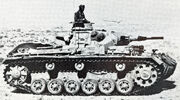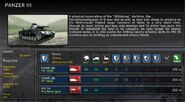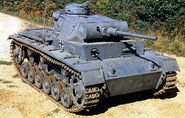| “ | Major! Two enemy tanks approaching! - Kowalski, Taking Command! |
” |
A physical incarnation of the "Blitzkrieg" doctrine, the Panzerkampfwagen III Ausf. G (later version) was fast as well as easy and cheap to produce, so the Wehrmacht fielded large numbers of them in a very short time. Though its main 50mm L/42 gun was only average and its armor was poor, the Panzer III remained the best in its category. An easy target for enemy medium tanks, it is still useful for hitting enemy infantry with its MG-34 machine-gun or striking at unprotected enemy flanks.
The Panzer III was one of the most common German battle tanks at the start of the war, serving in almost every invasion recorded. The Panzer III was designed during the interwar period as an infantry support tank, but later came to the battlefield to achieve the tank to tank role. The Panzer III enjoyed a great successful military career, serving as a vital tank in blitzkrieg attacks, but was later outclassed by the Russian T-34. As of this, the Panzer III was later replaced by the Panzer IV.
In-game, the Panzer III should only be used as a recon and to scout. Its armor is so incapable even strafing fighters can heavily damage it. Early attacking blitzkrieg tactics should have the Panzer III produced en masse, and attack alongside swarms of infantry. Later on, the Panzer III is almost useless, but can be used in large groups to take out anti-tank guns to provide a safe offensive for more capable armor.
History[]

German Soldier atop a Panzer III Ausf. J
On January 11, 1934, following specifications laid down by Heinz Guderian, the Army Weapons Department drew up plans for a medium tank with a maximum weight of 24,000 kg and a top speed of 35 kilometers per hour. It was intended as the main tank of the German Panzer divisions, capable of engaging and destroying opposing tank forces.
Daimler-Benz, Krupp, MAN, and Rheinmetall all produced prototypes. Testing of the prototypes took place in 1936 and 1937, leading to the Daimler-Benz design being chosen for production. The first model of the Panzer III, the Ausf. A, came off the assembly line in May 1937, and a total of ten, two of which were unarmed, were produced in 1937. Mass production of the Ausf. F version began in 1939. Between 1937 and 1940, attempts were made to standardize parts between Krupp's Panzer IV and Daimler-Benz's Panzer III.
Much of the early development work on the Panzer III was a quest for a suitable suspension. Several varieties of leaf-spring suspensions were tried on Ausf. A through Ausf. D before the torsion-bar suspension of the Ausf. E was standardized. The Panzer III, along with the Soviet KV heavy tank, was one of the first tanks to use this suspension design.
A distinct feature of Panzer III, influenced by British Vickers tanks, was a three-man turret. This meant that commander was not distracted with either loader's or gunner's tasks and could fully concentrate on maintaining situational awareness. Other tanks of the time did not have this capability, providing the Panzer III with a potential combat advantage. For example the French Somua S-35, had only one-man turret crew, and the Soviet T-34 (originally) had two-men. The practical importance of this feature is signified by the fact that not only all the further German tank designs inherited it, but also later into the war, most of the Allied tanks' designs either quickly switched to the three-man turret, or were abandoned as obsolete. The Panzer III, as opposed to Panzer IV, had no turret basket, merely a foot rest platform for the gunner.
The Panzer III was intended as the primary battle tank of the German forces. However, when it initially met the KV and T-34 tanks it proved to be inferior in both armor and gun power. To meet the growing need to counter these tanks, the Panzer III was up-gunned with a longer, more powerful 50-millimetre cannon and received more armor although this failed to effectively address the problem caused by the KV tank designs. As a result, production of self-propelled guns, as well as the up-gunning of the Panzer IV was initiated.
In 1942, the final version of the Panzer III, the Ausf. N, was created with a 75-millimetre KwK 37 L/24 cannon, a low-velocity gun designed for anti-infantry and close-support work. For defensive purposes, the Ausf. N was equipped with rounds of hollow charge ammunition which could penetrate 70 to 100 millimeters of armor depending on the round's variant but these were strictly used for self-defense.

The Panzer III was used in the campaigns against Poland, France, the Soviet Union and in North Africa. A handful were still in use in Normandy, Anzio, Finland and in Operation Market Garden in 1944. Although a handful were still out there, most were being shipped back to factories to be converted to StuG assault guns, as the defensive doctrine adopted by the German Armed Forces at the time demanded it.
By the end of the war, the Pz.III had almost no frontline use and many vehicles had been returned to the factories for conversion into StuG assault guns, which were in high demand due to the defensive warfare style adopted by the German Army by then.
Pros & Cons[]
This section is a stub, so be patient and expand it.
Weapons[]
| Weapon | ||||||||||
|---|---|---|---|---|---|---|---|---|---|---|
Small HE shell |
30 | 30 | 30 | 6 | 3 | 2 | 1 | 0 | 250m |
| Weapon | ||||||||||
|---|---|---|---|---|---|---|---|---|---|---|
Small AP shell |
100 | 20 | 12 | 8 | 5 | 4 | 250m |
| Weapon | ||||||||||
|---|---|---|---|---|---|---|---|---|---|---|
MG 34 |
26 | 26 | 250m |
Gallery[]
Notes[]
- The Panzer III is a cheap and effective early-game attack.
- Even in large numbers it is difficult for a Panzer III to deal with heavy tanks.
- The Panzer III is probably one of the fastest tanks and can be used to rush an enemy early on.
- In-game, the PzKpfw III is labeled as a light tank, when in actuality it was a medium tank.
See also[]
| ||||||||||||||||||||||||||


